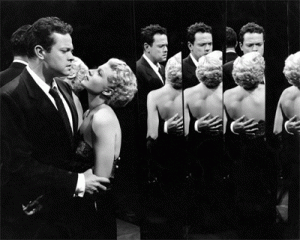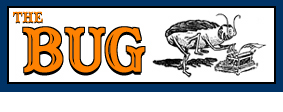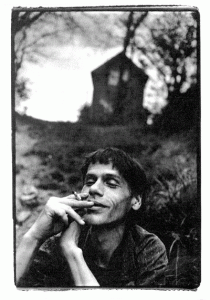 How do they do it? The good people who bring us alternative cinema, who plead and entreat their fellow citizens to give up a good day to attend something as magical as The James River Film Festival?
How do they do it? The good people who bring us alternative cinema, who plead and entreat their fellow citizens to give up a good day to attend something as magical as The James River Film Festival?
Smoke and mirrors, smoke and mirrors, that’s how.
For isn’t that’s cinema in a nutshell? Smoke reflecting off a screen, dazzling us and making us forget about life for awhile. A film festival is the same thing, writ large–good people conjuring up amazements with no money, feats of energy on few calories and less sleep, to bring the locals into places they’d never otherwise visit. And the movies! Small, perfect pictures like Jem Cohen’s Benjamin Smoke ten years in the making, or Celia Maysles’ Wild Blue Yonder, or, for that matter, Orson Welles’ The Lady From Shanghai, which seemed like a good idea at the time, was a disaster, and has since righted itself like a toy ship in a bathtub.
Don’t just sit there… well, OK, sit there and read but when you’re done thank your precious deity for these people. I met many of them this weekend. They struggle, look worn and weary and worried. But most of all they look happy. And amazed. If you don’t have those people in your life, well, I feel sorry for you. I really do.
For those of you not in the know, I attended last years’ James River Film Festival, in Richmond, Virginia, because James Parrish, Vice-President of the soon-to-be James River Film Society (nee Richmond Moving Image Co-op), was a good friend of my father’s. We met at Dad’s wake. Talking about movies allowed us to share memories of Dad and get our mind off things, and last year I came down to help screen a night of Magic and the Movies, in honor of Dad. That was a great time. From Melies to Godard to Hasil Adkins, that year’s festival was a joy, and I knew I wanted to come back.
So I made my way down again, to visit the good friends who make this festival work, which I know is a triumph of hard work over crushing reality. This time I was given the great pleasure of introducing Orson Welles’ The Lady From Shanghai. Thing was, Lady was Plan B, since our shared desire to show The Night of the Hunter fell through when the only print that we knew existed in the world was booked.
That first night saw one of the most amazing collaborations of music and silent film I’ve ever seen. Richmond band Hotel X blasted some great music, well, I think it’s called World Music (I might call it jazz) to some George Melies shorts. As much as I enjoy Melies, I think his work would have creeped me out when I was a kid. It certainly does today. In The Impossible Voyage a group of people travel on this crazy train/dirigible, get swallowed by the sun, escape burning by jumping into a refrigerated boxcar, only to freeze solid and get thawed. Among many other horrors, all tinted a brilliant red, blue and yellow.
The music was perfect, a driving, thumping beat which included steel drums, sax, guitars, and a guy dressed as a sort of Abe Lincoln in a long, black tunic. All of this took place in Plant Zero, in a large warehouse space. I like its address: 0 East 4th Street. Thus, Plant Zero.
The next day, a group of film loving souls took in a slew of documentaries, which was an act of complete and utter faith on our part: faith that the films were good (they were) and faith that we’d have another day as gorgeous as the one we were ignoring then (barring a climactic disaster, I’m guessing we will.) Each filmmaker acknowledged this as well, thanking us for coming into the dark on such a brilliant afternoon. The two features and two shorts I took in were very good, and one, For Memories’ Sake, blew me away. (Ignore the trailer, though, which doesn’t do the film justice.)
Ashley Maynor’s grandmother, Angela, always carried a camera around with her, an old 35mm number, and took at least a dozen photos a day… to the tune of 150,000 photos over 35 years. That’s one hundred and fifty thousand developed photos (since she got her digital camera a few years ago, that number has ballooned to over 200K).
Pictures of people, in all shapes, sizes, moods; of places, but not too many places, as she rarely ventured twenty miles from where she lived; and things: from plastic tigers to a any number of cakes to refrigerator magnets to pictures of the best pictures from the last roll. And then there’s her strange habit of taking self-portraits of herself dressed as a Native American. An amazing story, well told.
Celia Maysles’ Wild Blue Yonder was a personal favorite, the story of her attempt to come to understand her father, David Maysles. James, the man not the river, turned me onto the Maysles’ Brothers’ Salesman, already one of my all-time favorites. Yonder gets its title from Blue Yonder, an autobiographical film that David was working on before he died, and whose footage is in the clutches of his brother, Albert, the surviving brother.
What makes Wild Blue Yonder so compelling and, ultimately, heartbreaking, is Celia’s relationship with Uncle Albert. At first he’s welcoming and helpful, but as the film progresses he begins to get a bit prickly about the thought of this young woman making a movie about David, and especially using their footage. Eventually he threatens lawsuits, and Celia had to rely on the “Fair Use” part of the Copyright law to be able to use footage from Maysles films.
Celia is a soulful woman, as her father was a soulful man, and she’s easily brought to tears by the many wonderful stories related in the movie. But she’s also deeply frustrated trying to find out about her mysterious father. That Albert, the brother, refused her, and keeps her still today from looking at hours of footage of David (the leftovers from the movies), not to mention keeping stories to himself, made this viewer grind his teeth in anger. How frustrating this must be for Celia. That she seems to have moved on is a testament to her spirit.
Sunday night was my favorite at the Festival, however, as I watched three incredible movies, back-to-back-to-back. In celebration of Akira Kurosawa’s birthday (which was yesterday, by the way), the JRFF screened The Hidden Fortress, in a pristine print. What a great movie. The references to Star Wars were abundant, since, of course, Lucas stole them outright (C-3P0 and R2D2 are in both, except here they’re dopey soldiers), as he did from The Searchers, Errol Flynn swashbucklers, and even Triumph of the Will.
As I watched this movie, I was struck by how great Kurosawa’s storytelling abilities were, how were caught up and know every character and where this is going almost from minute one. Despite being two hours and thirty minutes, it felt brisk. And I thought how great a biography of Toshiro Mifune would be. I bet that guy’s some kind of crazy.
As the 8:30 showing of The Lady From Shanghai approached, I began to get a bit nervous. See, I was introducing Welles’ noir, and was worried I’d ramble. I’d clocked myself a few times, and found myself yakking for almost sixteen minutes–way too long while you’re waiting for a movie to start. I grew more and more anxious, worried I’d ramble like some crazy street preacher.
Fortunately, in-between The Hidden Fortress and Lady was Cohen’s Benjamin Smoke to soothe my nerves. I’d never heard of Benjamin Smoke, nor his band, Smoke. Right away I was taken in by the documentary, which is nothing more than interviews with Benjamin and footage of numerous performances–on stage, in an abandoned storefront, in his old house in Cabbage Town in Atlanta. But that’s like saying that road trip you remember forever was only a drive in a car with another person. It’s everything and nothing at all.
Benjamin Smoke is shot in beautiful black-and-white, in washed out colors that look as if they’re from an old photo album left in the sun too long, and feature Benjamin, talking about life, about Cabbage Town, about music. This is already one of my favorite documentaries of all time. My only sadness is that my Dad never lived to see it, because James and I agreed as we sat watching that he would have loved it. And he would have, he would have.
The Lady From Shanghai went swimmingly, I didn’t talk too long, or make to great a fool of myself. I told the great story of the movie, about how it went from being a conventional thriller, to having Rita Hayworth cast as Elsa Bannister by Columbia head Harry Cohn, who licked his chops at the publicity a Hayworth/Welles collaboration would make. They were married, secretly (to a degree) separated, but still trusting one another to make a movie together. He wanted to make a statement about celebrity and the Hollywood system, she wanted a part that would show the world she was more than a pinup.
Welles made one batshit crazy noir: two-and-a-half hours of discombobulating dialogue, camera-angles, and a plot that twists so much it became a Gordian knot that even Welles couldn’t untangle, so Cohn pulled out his sword and chopped it in half. 155 minutes became 87 minutes. And yet, even in the truncated edition Welles anger against wealth, his little stabs at Hollywood still shine through, and the editing helped add to the feelings of disorientation Welles’ desired. Lady works, and it helps to have an audience that could laugh at Welles’ ridiculous Irish brogue. That one critic still claims is perfectly authentic. Go figure.
On the way to see The Hidden Fortress I noticed a magician performing a brilliant slight-of-hand on a small table by a record store, and a young girl was utterly delighted by his tricks. It was the perfect touch to a great weekend.
The Festival continues on this week, and I wish I could see some of the other movies on the docket. I’m listening to Smoke a lot lately, reading the noir books James gave me as a present, and thinking of the Tennessee woman who keeps taking pictures every day. The Festival goes on, and that gives me reassurance that we still go to see old movies even as DVD and Blu-Ray and 3D and the general lazy tastes of the world continue to add elevation to the Sisyphean task the James River folks face every year. It made me think of Dad, and I was secretly pleased. No matter where this world goes, there’s still that very real need for us to be fooled, thrilled, and even comforted by smoke and mirror.

